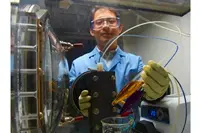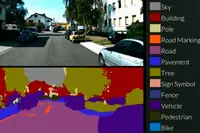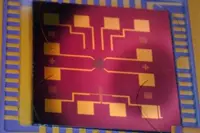Electronics News
Archive : 22 December 2015 год
 According to US researchers, energy storage system owners could see significant savings from a new flow battery technology that is projected to cost 60% less than today's standard flow batteries.
According to US researchers, energy storage system owners could see significant savings from a new flow battery technology that is projected to cost 60% less than today's standard flow batteries.
The organic aqueous flow battery is expected to cost £120 per kilowatt-hour once the technology is fully developed. The lower cost is due to the battery's active materials being inexpensive organic molecules, compared to the commodity metals used in today's flow batteries.
"Moving from transition metal elements to synthesised molecules is a significant advancement because it links battery costs to manufacturing rather than commodity metals pricing" said Imre Gyuk, energy storage programme manager for the Department of Energy's Office of Electricity Delivery and Energy Reliability (OE), which funded this research.
"The battery's water-based liquid electrolytes are also designed to be a drop-in replacement for current flow battery systems," said Wei Wang, materials scientist at Pacific Northwest National Laboratory (PNNL). "Current flow battery owners can keep their existing infrastructure, drain their more expensive electrolytes and replace them with PNNL's electrolytes."
Flow batteries generate power by pumping liquids from external tanks into a central stack. The tanks contain liquid electrolytes that store energy. When energy is needed, pumps move the electrolytes from both tanks into the stack where electricity is produced by an electrochemical reaction.
Unlike lithium-ion batteries that have issues with performance, safety and lifespan, limiting the technology's use for stationary energy storage, flow batteries store their active chemicals separately until power is needed, reducing safety concerns.
Nearly 79% of the world's working flow batteries are vanadium-based, according to data from the Global Energy Storage Database. While vanadium chemistries are expected to be the standard for some time, future flow battery cost reductions will require less expensive alternatives such as organics.
PNNL's new flow battery features two main electrolytes: a methyl viologen anolyte (negative electrolyte) and a 4-hydroxy-2,2,6,6-tetramethylpiperidin-1-oxyl, or 4-HO-TEMPO catholyte (positive electrolyte). A third, supporting electrolyte carries sodium chloride, whose chloride ions enable the battery to discharge electricity by shuffling electrons in the central stack.
"Using readily available materials makes our all-organic aqueous flow battery more sustainable and environmentally friendly. As a result, it can also make the renewable energy it stores and the power grid it supports greener," Wang said.
To test the new battery design, the researchers repeatedly charged and then discharged a 600mW battery at various electric current densities, ranging from 20 to 100mA/cm2. The test battery's optimal performance was between 40 and 50mA/cm2, where about 70% of the battery's original voltage was retained. They also found the battery continued to operate well beyond 100 cycles.
The team plans to make a larger version of its test battery that is able to store up to 5kW of electricity, which could support the peak load of a typical home. Other ongoing efforts include improving the battery's cycling so it can retain more of its storage capacity longer.
Pic: PNNL researcher Xiaoliang Wei prepares a small demonstration organic flow battery
Author
Tom Austin-Morgan
Source: www.newelectronics.co.uk
 Researchers from the University of Cambridge are developing technologies which use deep learning techniques to help machines to recognise their location and surroundings. The systems could be used for the development of driverless cars and autonomous robotics.
Researchers from the University of Cambridge are developing technologies which use deep learning techniques to help machines to recognise their location and surroundings. The systems could be used for the development of driverless cars and autonomous robotics.
The systems can identify a user’s location and orientation in places where GPS does not function, and identify the various components of a road scene in real time on a regular camera or Smartphone, performing the same job as sensors costing tens of thousands of pounds.
The first system, called SegNet, can take an image of a street scene it hasn’t seen before and classify it, sorting objects into 12 different categories – such as roads, street signs, pedestrians, buildings and cyclists – in real time. It can deal with light, shadow and night-time environments, and currently labels more than 90% of pixels correctly. Previous systems using expensive laser or radar based sensors have not been able to reach this level of accuracy while operating in real time.
For the driverless cars currently in development, radar and base sensors are expensive, often costing more than the car itself. In contrast with expensive sensors, which recognise objects through a mixture of radar and LIDAR, SegNet learns by example – it was ‘trained’ by a group of undergraduate students, who manually labelled every pixel in each of 5000 images, with each image taking about 30 minutes to complete. Once the labelling was finished, the researchers then took two days to ‘train’ the system before it was put into action.
“It’s remarkably good at recognising things in an image, because it’s had so much practice,” said Alex Kendall, a PhD student in the Department of Engineering. “However, there are a million knobs that we can turn to fine-tune the system so that it keeps getting better.”
The system is not yet at the point where it can be used to control a car or truck, but it could be used as a warning system, similar to the anti-collision technologies currently available on some passenger cars.
“Vision is our most powerful sense and driverless cars will also need to see,” said Professor Roberto Cupola, who led the research. “But teaching a machine to see is far more difficult than it sounds.”
As children, we learn to recognise objects through example – if we’re shown a toy car several times, we learn to recognise both that specific car and other similar cars as the same type of object. But with a machine, it’s not as simple as showing it a single car and then having it be able to recognise all different types of cars. Machines today learn under supervision: sometimes through thousands of labelled examples.
There are three key technological questions that must be answered to design autonomous vehicles: where am I, what’s around me and what do I do next. SegNet addresses the second question, while a separate but complementary system answers the first by using images to determine both precise location and orientation.
The localisation system designed by Kendall and Prof Cupola runs on a similar architecture to SegNet, and is able to localise a user and determine their orientation from a single colour image in a busy urban scene. The system is said to be more accurate than GPS and works in places where GPS does not, such as indoors, in tunnels, or in cities where a reliable GPS signal is not available.
It has been tested along a kilometre-long stretch of King’s Parade in central Cambridge, and it is able to determine both location and orientation within a few metres and a few degrees.
The localisation system uses the geometry of a scene to learn its precise location, and is able to determine, for example, whether it is looking at the east or west side of a building, even if the two sides appear identical.
“In the short term, we’re more likely to see this sort of system on a domestic robot – such as a robotic vacuum cleaner, for instance,” said Prof Cupola. “It will take time before drivers can fully trust an autonomous car, but the more effective and accurate we can make these technologies, the closer we are to the widespread adoption of driverless cars and other types of autonomous robotics.”
Author
Tom Austin-Morgan
Source: www.newelectronics.co.uk
 Researchers from MIT’s Microsystems Technologies Laboratories have claimed that a Microelectromechanical systems (MEMS) gas sensor could be produced by desktop 3D printing at one-hundredth the cost of traditional sensor fabrication techniques.
Researchers from MIT’s Microsystems Technologies Laboratories have claimed that a Microelectromechanical systems (MEMS) gas sensor could be produced by desktop 3D printing at one-hundredth the cost of traditional sensor fabrication techniques.
In 2014, MEMS were a $12billion business, but has traditionally required sophisticated semiconductor fabrication facilities, which cost tens of millions of dollars to build. Potentially useful MEMS have languished in development because they don’t have markets large enough to justify the initial capital investment in production.
“The additive manufacturing we’re doing is based on low temperature and no vacuum,” said Luis Fernando Velásquez-García, a principal research scientist in MIT’s Microsystems Technology Laboratories. “The highest temperature we’ve used is probably 60°C. In a chip, you need to grow oxide, which grows at around 1000°C. And in many cases the reactors require vacuums to prevent contamination. We also make the devices very quickly. The devices we reported are made in a matter of hours from beginning to end.”
Velásquez-García has been researching manufacturing techniques that involve dense arrays of emitters that eject microscopic streams of fluid when subjected to strong electric fields. For the gas sensors, Velásquez-García and Anthony Taylor, a visiting researcher from the British company Edwards Vacuum, used so-called ‘internally fed emitters’. These are emitters with cylindrical bores that allow fluid to pass through them.
In this case, the fluid contained tiny flakes of graphene oxide. Velásquez-García and Taylor used their emitters to spray the fluid in a prescribed pattern on a silicon substrate. The fluid evaporated, leaving a coating of graphene oxide flakes only a few tens of nanometres thick.
The flakes are so thin that interaction with gas molecules changes their resistance in a measurable way, making them useful for sensing. “We ran the gas sensors head to head with a commercial product that cost hundreds of dollars,” Velásquez-García says. “What we showed is that they are as precise, and they are faster.”
Electrospray could also lead to novel biological sensors, Velásquez-García says. “It allows us to deposit materials that would not be compatible with high-temperature semiconductor manufacturing, like biological molecules,” he says.
Author
Tom Austin-Morgan
Source: www.newelectronics.co.uk

